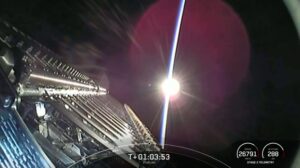Space News: SpaceX marks anniversary of first launch with Starlink mission

WASHINGTON — A SpaceX Falcon 9 launched another set of Starlink satellites March 24, 15 years to the day after the company’s first, unsuccessful launch.
The Falcon 9 lifted off from Space Launch Complex 40 at Cape Canaveral Space Force Station at 4:24 a.m. Eastern. The rocket’s upper stage deployed its payload of 60 Starlink satellites into low Earth orbit 64 minutes later.
The rocket’s first stage, on its sixth flight, landed on a droneship in the Atlantic Ocean eight and a half minutes after liftoff. That booster, which first launched last June carrying a GPS satellite, also launched Turksat 5A in January as well as three other Starlink missions.
This launch, by coincidence, took place exactly 15 years after SpaceX conducted the first launch of its Falcon 1 rocket from Kwajalein Atoll in the Pacific Ocean. That March 24, 2006, launch was unsuccessful, as the first stage’s single engine failed about half a minute after liftoff.
Two subsequent Falcon 1 launches also failed before the fourth Falcon 1 launch, carrying a test payload, reached orbit in September 2008. The Falcon 1 flew one more mission in 2009 before SpaceX retired the vehicle in favor of the far larger Falcon 9, which has become the company’s workhorse with more than 110 launches since its introduction in 2010.
This launch was the ninth Falcon 9 mission of 2021 and the fourth this month. Seven of those nine launches, including all four in March, have been dedicated to Starlink, increasing the size of the constellation to more than 1,300 satellites.
Growing capacity and international expansion
The growth of that constellation has been enabled by both the high launch cadence of the Falcon 9 and mass production of satellites. “We’re currently building roughly six satellites a day at our factory in Seattle, which is pretty remarkable,” Jonathan Hofeller, SpaceX vice president for Starlink, said at Spacetide, a Japanese space business conference, held online March 23. He said the company has maintained that production rate for about a year so far.
The satellites launched to date, he said, are all first-generation, or “Gen 1,” spacecraft. “We’re already working on the Gen 2 constellation,” he said. “These satellites will be continuously refreshed as we continue to increase both the network capacity and the density by orders of magnitude. We’re excited to be able to eventually provide a lot more internet than we’re even doing now.” He didn’t disclose additional details about the Gen 2 satellites or their schedule.
SpaceX plans to have global coverage for Starlink by the end of this year. However, as the company expands beta tests in the United States and several other countries, Hofeller noted that the satellite constellation alone is just one element of that rollout. Other key factors include establishing ground stations to serve as gateways as well as the regulatory process, which varies from country to country.
That regulatory process, he said, can be “very challenging” as the company explains its system to national regulators. “That process just takes a while.”
Japan, he suggested, is one the countries where that regulatory process is stretched out. Hofeller said the company identified Japan as a country where it wanted to provide service relatively early, and thanked those who have advocated for Starlink to Japanese regulators. “Anything they can do to speed up the regulatory process will be greatly appreciated,” he said, projecting that Starlink service could begin in Japan “as soon as the very end of this year.”
SpaceX has largely marketed Starlink directly to consumers, a move he said is intended to reduce costs to those customers while also providing a direct feedback loop to SpaceX to help it improve the service. However, as the company expands Starlink into other markets, which range from backhaul services for telecommunications providers to mobility applications, Hofeller said the company would be open to working with partners.
“We are a rocket company,” he said. “As we grow the capacity, it could be inevitable that we have partners globally.”
from SpaceNews https://ift.tt/3riSRLK